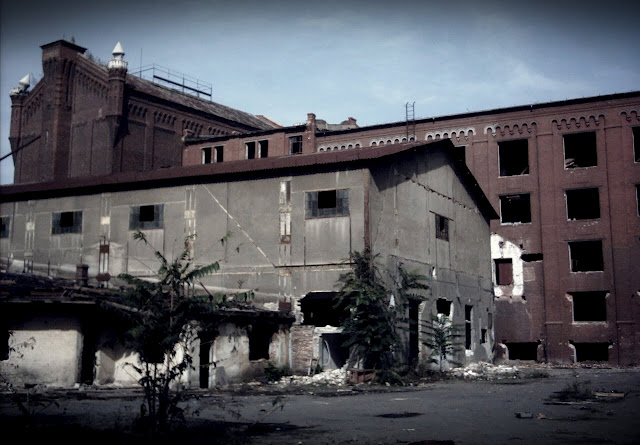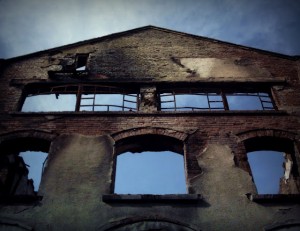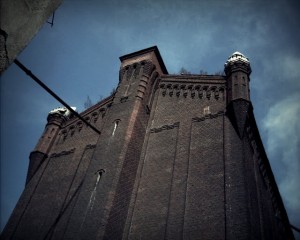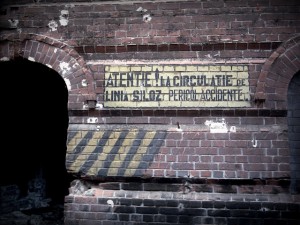Alternative Romania: Assan’s Mill, the first steam mill in Romania, now even closer to collapsing

 A 159- year old historic building complex in Bucharest, Assan's Mill (in Romanian Moara lui Asan) has attracted media attention from time to time, whenever it has deteriorated further. The complex of buildings, which once housed the first steam mill in Romania but are now no more than empty shells, were damaged by a fire at the beginning of June this year. It was not the first time the building was partially destroyed. In the past, a rushed semi demolition, a fire and a roof collapse helped turn it into the phantom property it is now.
A 159- year old historic building complex in Bucharest, Assan's Mill (in Romanian Moara lui Asan) has attracted media attention from time to time, whenever it has deteriorated further. The complex of buildings, which once housed the first steam mill in Romania but are now no more than empty shells, were damaged by a fire at the beginning of June this year. It was not the first time the building was partially destroyed. In the past, a rushed semi demolition, a fire and a roof collapse helped turn it into the phantom property it is now.
The recent fire on the 4.7 hectare property was intentional, fire fighters concluded. Media reports suggest the existing owners, two Cyprus – based companies, would like to build something else on the property, but as the building is protected as part of the patrimony, they cannot demolish it. Nature taking its course is the only way, which will likely raise questions on whether nature is being helped to take its course.
The central building in the complex, the red brick mill, with architecture reminiscent of a medieval fortress, escaped demolition but is in a critical condition.
The first wave of destruction at the compound, located in the Obor – Lizeanu area at 25 Halmeu St., began in 1995, when monument identification cards were cut off by unidentified persons. Archives and valuable furniture, left over from former owners of the plant were stolen. Equipment manufactured before the 1900 in Vienna was dismantled and sold for scrap parts.
 Assan’s Mill, the first steam mill in Romania, was partially demolished in 2005, in a hurry and without the necessary authorization. For real estate purposes, the 4.7 hectare plot of well positioned land values more than the historic buildings. In 2008, a large fire caused more damage. Earlier this year, one of the roofs collapsed and with it, one of the walls (with an area of 200 sqm). The collapse was allegedly caused by the theft of construction materials.
Assan’s Mill, the first steam mill in Romania, was partially demolished in 2005, in a hurry and without the necessary authorization. For real estate purposes, the 4.7 hectare plot of well positioned land values more than the historic buildings. In 2008, a large fire caused more damage. Earlier this year, one of the roofs collapsed and with it, one of the walls (with an area of 200 sqm). The collapse was allegedly caused by the theft of construction materials.
The site that was once the prize of the country is not guarded. Currently in an advanced stage of degradation, the mill was built by Gheorghe Assan (1821-1866) and Ioan Martinovici (1820-1882) on a field bought by Gheorghe Assan from Epitropia Ghica, the property expanding by acquiring land from nearby residents.
Equipment for the mill was brought from Vienna, from the Siegel company, and then transported down the Danube to Giurgiu, before being finally moved to Bucharest. The transfer of the equipment alone took almost a month.
 In 1865, Gheorghe Assan remained the sole owner of the factory. After his death in 1866, company management remained with his wife, Alexandrina, who left it to her two sons in 1884, Basile and Gheorghe, who had studied abroad. In 1894, the two founded a new section at the mill. At that time, the mill was grinding seven wagons of wheat in 24 hours. By 1895, there were nine other steam mills besides Assan’s Mill.
In 1865, Gheorghe Assan remained the sole owner of the factory. After his death in 1866, company management remained with his wife, Alexandrina, who left it to her two sons in 1884, Basile and Gheorghe, who had studied abroad. In 1894, the two founded a new section at the mill. At that time, the mill was grinding seven wagons of wheat in 24 hours. By 1895, there were nine other steam mills besides Assan’s Mill.
After 1903, Assan mill was equipped with electricity, coming from its own generator. In June 1930, the company that owned it was converted into stock under the name Anonymous Society "Assan factories", which included four different industries: grinding grain, vegetable oils, paints and colors, and soaps. Before the mill was transformed into a limited company, the brothers Assan had 33 workers.
In January 1946, after the war, the factory had 400 employees. It was constantly updated with the latest equipment and technology, as the owners, the Assan brothers, were interested in the newest technology and always up to date with what was state of the art abroad.
The Assan Mill property originally included 5.41 hectares, but it shrunk to 4.7 hectares as communist era blocks were built in the area. By that time, the property had already been nationalized – that happened in 1948. The same year, Basile Assan, then the sole owner of the Mill, was arrested, tortured and committed suicide while in Police custody.
The Assan Mill compound served for production during the communist period, as a bread factory 'Spicul' and as the oil factory "13 December".
 Not all equipment originally on site was lost. Parts of the mill machinery went to the Technical Museum Dimitrie Leonida and other institutions. Currently, the Technical Museum in Bucharest has the cylinder mill steam plant "Assan" dating from 1853.
Not all equipment originally on site was lost. Parts of the mill machinery went to the Technical Museum Dimitrie Leonida and other institutions. Currently, the Technical Museum in Bucharest has the cylinder mill steam plant "Assan" dating from 1853.
In the '90s, the Assan's Mill complex became the property of SC "Graul" SA and "Solaris" SA, but financial difficulties led to the liquidation of assets.
Ioana Toader, ioana.toader@romania-insider.com
(photo credits: Alex Iacob, http://reptilianul.blogspot.













